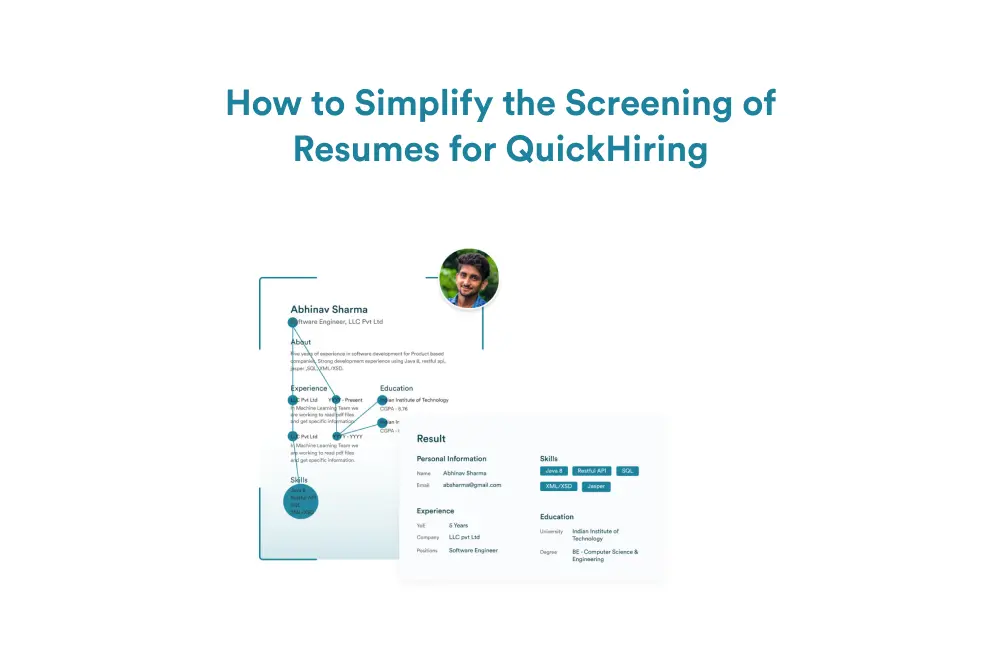Organizations must devise effective methods for screening resumes and selecting the most eligible people in the cutthroat employment market of today. Employers may save time, boost productivity, and hire people more successfully by streamlining the resume screening procedure. In order to ensure effective recruiting, this article will examine the value of resume screening, discuss what to look for while analyzing resumes, and offer advice for expediting the procedure.
Why Resume Screening Matters
Resume screening is the initial step in the recruitment process and plays a crucial role in identifying potential candidates resumes who possess the required skills and qualifications. With a large number of resumes to review for each job opening, it can be time-consuming for hiring managers to assess every application thoroughly. However, a well-executed resume screening process can help eliminate unqualified candidates and identify those who meet the necessary criteria.
Resume screening is more crucial than ever in the competitive job market of today, where hundreds of individuals may submit applications for a single vacancy. Employers may quickly go through a sea of resumes and concentrate on the most qualified applicants. Hiring managers can pinpoint candidates who have the precise qualifications and experience required to succeed in the position by carefully evaluating each CV.
Additionally, resume screening involves more than just assessing credentials and experience. Additionally, it gives employers a chance to judge whether a candidate will fit in with the organization’s culture. Businesses frequently have an own set of beliefs, workplace culture, and team dynamics. Employers can find individuals that fit with the company’s culture and values while still possessing the necessary capabilities by carefully examining resumes.
Long-term success depends on selecting candidates who mesh with the corporate culture. A positive work atmosphere is fostered and overall productivity is increased when coworkers get along well and uphold the same principles. Contrarily, recruiting people that do not fit well with the company culture might result in conflicts, low morale, and a higher turnover rate.
Additionally, a properly implemented resume screening procedure can assist both companies and candidates save time and resources. Hiring managers can concentrate their resources on interviewing and analyzing candidates who have a higher chance of succeeding in the position by effectively eliminating unqualified applicants. This not only saves time, but also guarantees a transparent and effective hiring procedure.
Overall, resume screeners is a critical step in the recruitment process that allows employers to identify the most qualified candidates while also considering their fit within the company culture. By carefully reviewing resumes, hiring managers can make informed decisions and ensure that only the best candidates move forward in the hiring process. So, next time you submit your resume, remember the importance of this initial screening and make sure your application stands out from the rest.
When screening resumes, what to look for
It’s crucial to consider particular factors when judging resumes so they meet the needs of the position. Focusing on pertinent data that demonstrates the candidate’s credentials and experience is crucial.

1. Relevant Skills: Look for abilities that the job description specifically mentions and that are relevant to the position. Technical know-how, software expertise, or knowledge of a particular industry could all be considered among these capabilities.
For instance, when recruiting for a software developer role, essential skills to look for would include proficiency in programming languages, database management, and problem-solving capabilities. These competencies are vital for excelling in the position and demonstrate that the candidate possesses the required expertise.
2. Work Experience: Take into account the candidate’s prior work experience and its alignment with the applied position. Focus on pertinent job titles, responsibilities, and achievements that showcase the candidate’s capacity to excel in the role proficiently.
Let’s say you are recruiting for the role of marketing manager. If so, you would want to see prior expertise in marketing or closely connected industries, including brand management or market research. Achievements like effective campaign launches or higher revenue can also show that a candidate is able to produce outcomes
3. Evaluation of the Candidate’s Education and Certifications: Review the Candidate’s educational background and any Certifications they may hold. Examine whether their experience and education complement the position’s needs or otherwise enhance it.
Specific degrees or certificates are required for particular occupations, such as engineers or healthcare professionals, to verify the applicant has the relevant training and experience. However, it is crucial to additionally take into account how their education relates to the position. For instance, a candidate with a marketing degree may be better suited for a marketing position than a candidate with a finance degree.
4. Pay attention to the keywords that are frequently used in the industry or the particular employment field. Candidates who use these keywords show that they are knowledgeable about the field and may be a suitable match for the position.
5. Utilizing the appropriate keywords in their CV demonstrates that the applicant is familiar with the lingo and ideas involved in the position. This may suggest that they have knowledge or experience in the area, increasing their chances of success in the position. For instance, finding phrases like “social media strategy,” “content creation,” and “analytics” can show that the applicant is knowledgeable in the sector if you are hiring for a social media manager role.
By evaluating these four critical factors during the resume screening process, you can guarantee that you’re choosing candidates who possess the essential qualifications and experience for the job. Additionally, be vigilant about spotting any supplementary relevant information or distinctive qualities that might distinguish a candidate from others.
Tips for Streamlining the Process
Now that we understand the importance of resume screening and what to look for when evaluating resumes, let’s explore some tips for streamlining the process.

Streamlining the resume screening process is crucial for efficient hiring. By implementing effective strategies and utilizing technology, you can save time and resources while identifying the best candidates for the job.
- Clearly state the job requirements
Start by outlining the demands and expectations of the position. This will enable you to rapidly determine whether a candidate satisfies the crucial requirements and develop a checklist.
When determining job requirements, take into account the particular abilities, credentials, and experience required for the position. Outlining these standards in clear terms will help you not only filter resumes but also guarantee that you only recruit applicants who are a good fit for the position.
- Put an applicant tracking system (ATS) into action
The screening of resumes can be greatly streamlined with an applicant tracking system (ATS). By utilizing keywords and filters to swiftly identify qualified individuals, these systems enable you to automate the screening procedure. Additionally, an ATS makes it possible to manage resumes effectively, enhancing teamwork among hiring managers.
With the use of an ATS, you can quickly look for particular talents or qualifications, making it simpler to find people that satisfy your requirements. Furthermore, ATS systems frequently offer functions like resume parsing, which takes important data from resumes and populates it in a standardized format for straightforward comparison.
- Utilize Screening Questions
Incorporating screening questions into the application process can help filter out candidates who do not meet the basic requirements for the position. These questions can be used to assess essential skills, experience, and qualifications.
By including screening questions, you can gather specific information from candidates upfront, allowing you to quickly eliminate those who do not meet the minimum requirements. These questions can be tailored to assess critical competencies or job-specific knowledge, ensuring that only the most qualified candidates move forward in the hiring process.
- Create a scoring or rating system
Create a rating or scoring system to evaluate resumes with objectivity. Prioritizing candidates and ensuring consistency in the selection process can both be achieved by assigning scores to various criteria.
A rating or score system offers a consistent method to assess resumes. You can evaluate candidates based on qualifications by giving grades to various factors, such as relevant experience, schooling, or particular skills. Due to the system’s clear framework for evaluating resumes, hiring teams may work together more easily.
- Conduct Pre-Screening Interviews
Consider conducting pre-screening interviews to gather additional information about candidates. These interviews can help you assess soft skills, communication abilities, and cultural fit before moving candidates forward in the hiring process.
Pre-screening interviews can be conducted over the phone or through video conferencing tools. These interviews allow you to ask candidates specific questions related to the job requirements and evaluate their responses. By assessing soft skills and communication abilities early on, you can determine whether a candidate aligns with your company’s culture and values.
Keep in mind that speeding up the resume screening procedure will enable you to identify the top candidates quickly in addition to saving time. Implementing these suggestions will help you screen resumes more effectively and choose prospects for further consideration with greater knowledge.
Changing the Evaluation Process for Your Resume
Are you weary of wasting countless hours sorting through mountains of resumes in search of the ideal applicant for your business? Look nowhere else! In this post, we’ll look at some insightful advice and tactics that might help you streamline and improve your resume evaluation procedure.
Establishing a clear list of the credentials and qualities you seek in a candidate is one of the first steps you can take to expedite the resume screening procedure. Spend some time examining the job description attentively and determining the essential skills needed for the position. This will not only make the process of filtering resumes more successful, but it will also guarantee that you are focusing on the most crucial factors.
Once you have defined your criteria, it’s time to establish a standardized evaluation system. This can be as simple as creating a scoring rubric or checklist that allows you to objectively assess each resume. Assign points or ratings to different sections, such as education, work experience, and skills, based on their relevance to the job. This system will help you compare candidates more easily and make more informed decisions.
Another useful tip is to leverage technology to your advantage. There are numerous resume screening tools available that can help you automate the process and save valuable time. These tools use artificial intelligence and machine learning algorithms to analyze resumes and identify the best matches based on your predefined criteria. By utilizing such tools, you can significantly reduce manual effort and increase the accuracy of your screening process.
However, it’s important to remember that technology should not replace human judgment entirely. While resume screening tools can be incredibly helpful, they are not foolproof. It’s essential to review the results generated by these tools and use your own expertise to make the final decision. Trust your instincts and take into account factors that cannot be captured by an algorithm, such as cultural fit and soft skills.
Consistency is key when it comes to resume evaluation. Make sure that all members of your hiring team are on the same page and follow the same evaluation process. This will help eliminate bias and ensure that every candidate is evaluated fairly. Consider conducting regular training sessions to educate your team on best practices and provide them with the necessary tools to evaluate resumes effectively.
Lastly, don’t forget to continuously evaluate and refine your resume evaluation process. Solicit feedback from your team and candidates to identify areas of improvement. Keep up with the latest trends and best practices in resume screening and incorporate them into your process. By constantly striving for improvement, you can ensure that your hiring process remains efficient and effective.
In conclusion, transforming your resume evaluation process is not an overnight task. It requires careful planning, clear criteria, the right technology, and a commitment to continuous improvement. However, by implementing these tips, you can streamline your resume screening process and identify the most qualified candidates for efficient hiring. Remember to consistently evaluate and refine your process to improve efficiency and make more informed hiring decisions. With a well-structured and effective resume screening process in place, organizations can save time, resources, and ultimately hire the best talent for their teams.










